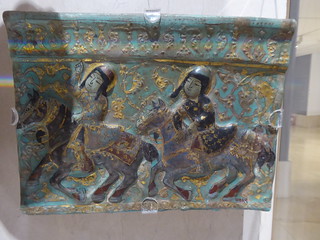Ilkhanid Frieze Tiles, Takht-i Sulaiman (Sughurlukh), Kashan and Rayy, late 13th century.
Rest the cursor on a thumbnail to see the caption, click for a larger image.
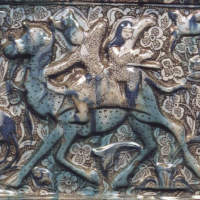
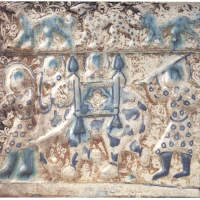
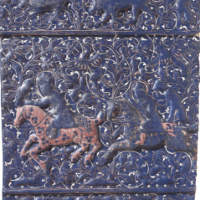
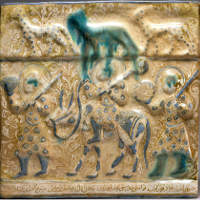
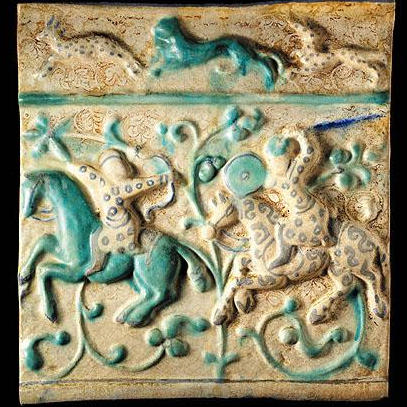
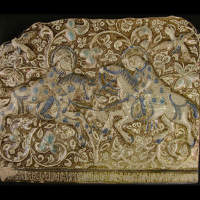
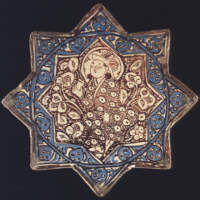
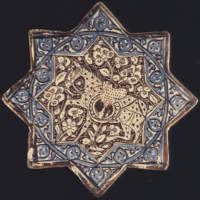
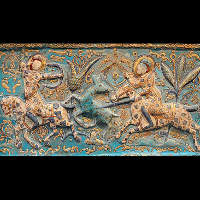
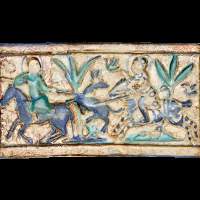










Text link to the larger images:
Ilkhanid Frieze Tile with Bahram Gur and Azada on a Camel, Takht-i Sulaiman, Iran, second half 13th century. Victoria and Albert Museum, London, 1841-1876.
Ilkhanid Frieze Tile with Elephant and Rider, Takht-i Sulaiman, Iran, 1270s. Los Angeles County Museum of Art M.73.5.222.
Ilkhanid Frieze Tile with Hunt Scene, Takht-i Sulaiman, Iran, 1270s. Miho Museum, Shigaraki, Japan (SS1480).
Ilkhanid Frieze Tile with Faridun Riding Birmaya, Takht-i Sulaiman, Iran, late 13th century. Walters Art Museum 48.1296.
Ilkhanid Frieze Tile with Two Hunters, Kashan, Iran, second half 13th century. Metropolitan Museum of Art, New York. 10.9.1.
Ilkhanid Frieze Star Tile with Seated Man, Kashan, Iran, second half 13th century. British Museum, London, OAG 1983.212.
Ilkhanid Frieze Star Tile with Saddled Horse, Kashan, Iran, second half 13th century. British Museum, London, OAG 1983.229.
Tile with mounted hunt scene, Kashan or Rayy, Iran, 13th century AD, Staatliche Museen. Berlin I.6218.
Tile with mounted hunt scene, Iran, 12th-13th century AD, Keir Collection 184.
Thus if they want to compound a body out of which to make pottery objects . . . and house tiles, they take ten parts of the aforementioned white shukar-i sang . . . and one part of ground glass frit mixed together and one part of white Luri clay dissolved in water.
—Abu a1-Qasim ʿAbd Allah Kashani, Treatise on Ceramics1
The tiles of Takht-i Sulaiman are composed of a fritware body glazed with either a translucent alkali glaze or a tin-opacified lead-alkali glaze. This material is referred to by a confusing variety of names: quartz-frit-clay paste, quartz-frit, faience, composite ware, artificial paste, stonepaste, and kashi.
Source: p. 233, "The Glazed Press-Molded Tiles of Takht-i Sulaiman" JOHN HIRX, MARCO LEONA, AND PIETER MEYERS in The Legacy of Genghis Khan Courtly Art and Culture in Western Asia 1256-1353
Fig. 88. View of the West Iwan of the palace at Takht-i Sulaiman, Iran, with the lake in the foreground
TAKHT-I SULAIMAN, THE REMAINS OF AN ILKHANID PALACE
Only one actual setting of Ilkhanid courtly life survives, the seasonal palace known as Takht-i Sulaiman (fig. 88). The archaeological site, on a mountainside at an elevation of about 7,900 feet, is in the Azerbaijan region of Iran, two hundred miles south of Tabriz and southeast of Lake Urmia. The camp was a walled town of oval shape about a third of a mile long and a quarter mile wide and contains a small lake. Its Ilkhanid structure was built over a Zoroastrian sanctuary that dates from the Sasanian period (224-651). The palace remains, excavated by the German Archaeological Institute between 1959 and 1978, provide valuable evidence about the physical nature of an Ilkhanid seasonal camp.38 The function of its various parts can to some degree be reconstructed from the writings of Rashid al-Din.
Takht-i Sulaiman, literally meaning “Throne of Solomon,” is a name given to this site long after the Ilkhanid reign, probably during the Safavid period (1501-1722), when it appears in a historical document by Qadi Alnnad al-Qumi.39 It is likely that the name comes from “Sulaiman-makan” (one who takes Solomon’s place), one of the epithets of IsmaʿilI (r. 1501-24), the first Safavid ruler, who visited the spot several times. A geographical survey written by Hamd Allah Mustaufi Qazvini in 1340 that contains a description of the site allows us to identify Takht-i Sulaiman with the Ilkhanid summer camp Sughurlukh. Writes Mustaufi Qazvini about Sughurlukh:It stands on the summit of a hill and it was originally founded by King Kay Khusraw the Kayanian. In this town there is a great palace, in the court of which a spring gushes forth into a large tank, that is like a small lake for size, and no boatman has been able to plumb its depth. . . .This palace was restored by Abaqa Khan the Mongol, and in the neighbourhood there are excellent pasture grounds. Its revenues amount to 25,000 dinars.40Mustaufi Qazvini’s attribution of the Ilkhanid palace to Abakha is in accord with the archaeological evidence at Takht-i Sulaiman. Construction of the palace there must go back at least to Abakha’s reign (1265-82), because luster-painted tiles excavated at the site carry the dates 670, 671, and 674. (A.H.), that is, A.D. 1271-73 and 1275-76.
History of the Site
The Ilkhanid structure at Takht-i Sulaiman was built over a Sasanian fire temple of Adur Gushnasp that seems to have been in use from the late fifth to the early seventh century. Adur Gushnasp, one of the three sacred fires of Zoroastrianism, is often associated with the legendary Iranian king Kaikhusrau the Kayanian, who founded its altar in Azerbaijan, according to a Zoroastrian tradition.41 In Arabic sources of the ninth and tenth centuries the site was called Shiz, and it is reported that a Persian king customarily visited the temple there on foot when he was newly crowned.42
The Ilkhanids renamed this site Sughurlukh, in Turkic “place abounding in marmots” (Turkic toponyms were very commonly used throughout the Mongol empire). The marmot is frequently hunted in Mongolia, and its fur is highly prized. Presumably the spot was selected for an Ilkhanid summer camp because of its suitability as a hunting ground rather than because of its glorious Zoroastrian past.
In the Jamiʿ al-tavarikh (Compendium of Chronicles) of Rashid al-Din, Sughurlukh figures in a complex family drama, although less in connection with Abakha himself than with Abakha’s son Arghun, his grandson Ghazan, and his wife Bulughan Khatun the Elder.43 Ghazan, according to Rashid al-Din, was born in Mazandaran in the year corresponding to 1271. When he was three years old he was taken by his father, Arghun, then governor of Khurasan, to see his grandfather Abakha at Khongkhur Öleng. Abakha became very fond of the boy and told Arghun that he would oversee Ghazan’s education. Since Abakha’s favorite wife, Bulughan Khatun, had no son, Arghun suggested that the child be entrusted to her care. Rashid al-Din writes:
Abakha was pleased [with this idea], and Bulughan Khatun proceeded to Sughurluq. Arghun followed her bringing Ghazan’s belongings, then returned to Khurasan. Bulughan Khatun was overjoyed; she called [the child] god’s gift, who to her was like her own son. Arghun left [Ghazan] ten servants . . . from the tribe of Önggüt [a Turkish tribe]. Abakha said, “Ghazan should remain in this ordu, and this ordu should belong to him. And after me this ordu shall be his, and he shall be its head.” Most of the time Prince Ghazan stayed in Bulughan Khatun’s ordu.44Bulughan Khatun (the Elder) was Abakha’s tenth wife and was favored by Abakha over his other wives. The passage quoted suggests that the palace at Takht-i Sulaiman did indeed belong to Abakha and that the ordu led by Bulughan Khatun was based there, although it may not have been permanently located there.
Following the Mongol custom, after Abakha’s death in 1282 Bulughan Khatun was married to his son Arghun. Rashid al-Din writes that she even acted as Arghun’s deputy when he was absent.45 When Bulughan Khatun died in 1286, Arghun inspected her treasury, Which was filled With precious jewelry and pearls given to her by Abakha. After taking some of the robes and gold and silver Ware for himself, Arghun said that, in accordance with Abakha’s wishes, the rest of the treasure, the yurt (appanage), and the ordu should be sealed and kept for Ghazan.46 Although Rashid al-Din does not specify where Bulughan Khatun’s treasury was, it may have been at Sughurlukh, and Arghun’s unusually long stay at Sughurlukh that year may have been in order to inspect her treasury.
In 1290 Arghun married another Bulughan Khatun and granted her the ordu that had belonged to Bulughan Khatun the Elder.47 Thereafter, Sughurlukh was frequently mentioned in association with the new Bulughan Khatun. After Arghun’s death in 1291, a struggle for her arose among three aspirants to the throne: Arghun’s son Ghazan, Arghun’s brother Geikhatu, and Arghun’s cousin Baidu. She was married to Geikhatu (r. 1291-95) in 1292, but later Ghazan married her, according to Islamic law, when he was enthroned in 1295. The great interest members of the royal family showed in these two Bulughan Khatuns seems to have been partly motivated by their wealth, originally given by Abakha to the Elder and then passed to the Younger, and probably kept at Sughurlukh. Arghun’s own treasury was also situated at Sughurlukh, although Rashid al-Din states that after his death it was stolen or wasted by Geikhatu and Baidu (r. 1295) and that nothing remained when Ghazan came to the throne.48
Rashid al-Din makes frequent mention of amirs being stationed at Sughurlukh. He also records stays there of the reigning Ilkhan, usually only for a few days as a rest stop on a long journey. Sometimes an Ilkhan handled state affairs during his stay at Sughurlukh; for example, Arghun issued an edict there in 1284 appointing Bukha as his vizier and another in 1289 appointing Saʿd al-Daula vizier.49
Sughurlukh/Takht-i Sulaiman, a summer residence of the Ilkhans, was apparently smaller and politically less important than those in Ala Tagh and Arran, since no khuriltais or enthronements were held there. However, it may have had its own particular significance as the site of the treasuries belonging to the two Bulughan Khatuns and to Arghun.
Source: pp. 84-88, "Ilkhanid Courtly Life" TOMOKO MSUYA in The Legacy of Genghis Khan Courtly Art and Culture in Western Asia 1256-1353
